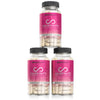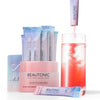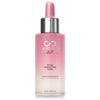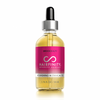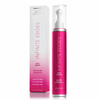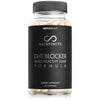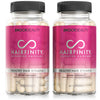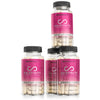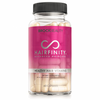
Why Is My Hair Thin at the Ends But Thick at the Roots?
You might be surprised to see your hair becoming too thin at the ends and thick hair at the roots. And then you start wondering why your once lustrous and thick hair from root to tip looks thinner at the ends and thicker at the roots. Unfortunately, it happens.
However, you shouldn't at any point accept it as a product of getting older. It has nothing to do with age; it can happen to anyone at any age. So, don't despair. Many reasons can be associated with hair being thin at the ends and thick at the roots.
Keep reading to discover what causes hair to thin on the ends and simple routines you can follow to restore the thickness of your hair ends.
What Causes Hair To Thin On Ends
As reiterated above, one can link many reasons to the thinning of hair at the ends.
Normally, the hair growth cycle goes round the clock for about eight years. And, during those periods, our hair has been frequently exposed to harsh conditions that might be unfavorable, resulting in thinning of the hair ends.
Here, we will be addressing the causes of hair thinning at the ends to enable us to grasp it fully.
1. Frequent Use of Heat Styling Tools
Heat can cause split-ends, breakage, and dryness in your hair. You can prevent this by using higher quality products and waiting for your hair to air dry before using heat styling tools.
- Dry hair
Dry and brittle hair can cause hair to thin on the ends. You might have noticed that hair is made up of proteins. So, to maintain natural well-moisturized hair, use hair products (hair creams, shampoos, leave-in conditioners) that are good hair moisturizers.
You can also eat foods that are good sources of Vitamin A. Vitamin A produces sebum (an oily substance) that makes for natural moisturized hair.
If you have fine hair, avoid heat protectants that contain alcohol- they'll dry out your strands even further!
- Split ends
One of the indications that damaged and thinning hair gives is split ends. About the tip, they are the result of trauma to the hair shaft. Split ends can be caused as a result of;
- Roughly combing and brushing hair,
- Usage of styling products made with ingredients that are not safe for the hair- like gels and pomades,
- Chemical treatments such as perms, relaxers, or dye on your locks.
- Natural dry and brittle hair strands.
There are many ways you can protect your hair from the effects of heat, such as using a product containing natural oils for shine and protection before blow-drying or using products containing argan oil after washing your hair.
2. Regular washing of hair
You do need to wash your hair but avoid daily washing of hair. A product of frequent washing is dry and brittle hair. Frequent washing causes the natural oils in your hair to get washed off from your hair follicles, which causes the protective layer on each strand to thicken—making it more difficult for moisture (from water or otherwise) to reach them. As a result, your hair becomes duller-looking and coarse-feeling.
The effects of frequent washing aren't just cosmetic: As we mentioned, frequent shampooing can cause breakage — one of the most common problems associated with thinning ends. If you're worried about having unhealthy strands at the bottom of your mane (and who isn't?), skip washes whenever possible!
3. Not detangling your hair properly before shampooing
You can detangle your hair before shampooing it with a wide-toothed comb.
Apply a detangling spray if you have thick or very curly hair.
Part sections of your hair into manageable, thin pieces and separate them with clips or bobby pins as you work through the tangles with a wide-tooth comb from tip to root. It would be best to start at the bottom of each section, and work tangles out as you move up your strands to avoid compacting tangles down your hair.
4. Using the wrong shampoo
Using the wrong shampoo can make your hair more prone to breakage and thinning. It has its reasons:
Shampoos that contain sulfates can dry and wash off the natural oils from your scalp, making it harder for your roots to produce enough volume. You may need an extra-hydrating shampoo that uses proteins instead of sulfates as an ingredient.
Shampoos with silicone ingredients can weigh down your hair, causing it to fall flat and look thinner than normal. This is because the silicone acts as a barrier on the strands, preventing them from getting any lift or volume when they're dry. Try finding a volumizing shampoo without silicones in it!
To avoid dryness, choose shampoos without alcohol as an ingredient (this includes glycerin). Alcohols like cetyl alcohol are often found in anti-dandruff shampoos; however, they can also be damaging if used too frequently or heavily on oily scalps—so if you have dandruff problems but still want healthier styling products for your hairs, try switching over from dandruff treatments into something else entirely
5. Using conditioner incorrectly
Do not apply your conditioner incorrectly. When you think about it, the ends of your hair are much longer than the roots. So, we can deduce that the hair ends require additional conditioning than the roots. The best way to apply conditioner is to start at the bottom of your hair and work your way up, putting on extra as you reach each new section until you've covered everything from root to tip.
6. Hair color damage
Hair color damage is another cause of hair thinning on the ends. Most of the time, this occurs when you opt for low-quality hair colors for your hair type. Since you'll like to dye your hair, always seek the opinions of your professional hair stylist on the best hair color to opt for.
If you are a blonde and decide to opt for a new dark brown shade, your stylist might tell you to leave the dye on a bit longer than normal, so it takes better. But if this turns into a long-term thing (like every time), then that dye will damage your hair each time you use it. If your hair is already dry and brittle because of previous bleaching or treatments, adding more heat may result in even more breakage and damage over time.
When choosing whether or not to color your hair at home – or have someone else do it- make sure they know which hair color should be used based on how damaged your strands are! Also, remember how often they suggest using certain products before deciding what results are acceptable for you. A little extra shine may seem like a bonus now but lead to more serious issues later if care isn't taken now!
7. Applying too much of bleaching products to your hair
When bleaching your hair, avoid bleaching products containing hydrogen peroxide as it can damage your hair, resulting in thinning hair ends.
Also, the more bleach you add to your hair, the larger the damage you are doing to your hair. It may improve your appearance at the moment but does more damage than good to your hair. For instance, if you bleach 1 inch of your roots every two weeks and want to maintain that same shade of blonde, then after a while, it's going to take more and more bleaching products until, eventually, they don't work. Anymore because there's nothing left!
You may be able to get away with DIY bleaching if you are only doing an inch or so each time ( and preferably not every two weeks), but this is still risky – never underestimate how easy it is for things like this to go wrong! It's much better off to seek help from hair therapists who can give you the best advice on what to do and the kind of bleaching products to purchase rather than trying something out yourself without any experience.
8. Under-nourished hair
Your hair can also thin on the ends due to a deficiency in essential vitamins, minerals, or other nutrients. An inadequate supply of nutrients to the scalp and roots of the hair can retard the growth of the hair. Furthermore, it may not allow the nutrients to reach the hair ends for strengthening and thickening.
9. Iron deficiency
Iron deficiency can result in dry hair that breaks easily with little pressure applied during brushing or combing. If you are experiencing any of these symptoms, along with thinning hair at the ends, ask your doctor about supplementing with extra Iron on top of eating foods rich in this nutrient ( liver is one such food). You'll also want to avoid drinking tea when consuming multiple vitamins containing Iron since tannins in those beverages can alter their absorption into the body's system.
Simple routines that you can adopt to restore your thick hair ends
Thin hair ends are not a permanent problem. Observing simple routines can restore your thick hair ends, and the solution is simple. Take good proper care of your hair.
Here are some of the ways you can take care of your hair;
- Nourish your body with the right nutrients- If your body lacks nutrients, your hair won't grow as much as it should due to lack of nutrients. So, eating the right foods can restore your thick hair ends back. To maximize all the essential nutrients needed, you can take multivitamins.
- Use either a silk pillowcase or a loose bun while sleeping- Some people wake up and meet more than 150 strands on their pillow due to friction on the hair, resulting in breakage. A silk pillowcase will help reduce friction and maintain the natural oils on your hair without soaking it.
- Prioritize using hair protectants before applying heat styling tools.
- Deep condition once a week by applying a leave-in conditioner. Try as much as possible to wrap your hair in cling film for fifteen minutes (or longer if you have time) and rinse with cool water.
- Use a hair mask once every month, especially for those with locks. This will give the hair an extra boost of hydration and nutrition.
- Use gentle shampoos that won't strip away all the natural oils in your scalp, which can cause dandruff and other unpleasant symptoms. You can opt for shampoos that are perfect blend for your hair type, thus preventing damage while nourishing strands simultaneously!
- You should always wash your hair with shampoo and a leave-in conditioner. The reason is that a leave-in conditioner enhances the appearance of your hair, giving it a lustrous look. It also helps prevent thinning hair ends by hydrating the hair and providing heat protection before you style it.
- After washing your hair, it's better to air-dry it rather than rub your towel all over your hair or blow-drying it.
- Avoid excessive combing of hair. Excessive and rough combing of hair causes hair fall and damages the hair cuticle, resulting in the thinning of hair.
- Trim your hair once in a while. Trimming some hair ends can result in the growth of the hair inches and the thickening of hair ends. This is because some hair ends might have been weakened and may need to get cut off.
- Select hairstyles that do not pull your strands due to the tension exerted on the roots. Frequent tight- styles on your hair can cause thinning of hair ends and fall out of hair strands, too, especially when carried for a long period. Examples of tight hairstyles for better understanding include; Dreads, braids, and high or tight ponytails.
Conclusion
As reiterated above, there are several reasons your hair is thinning at the ends. However, this problem is mostly temporal and can be handled with a few simple changes in your routine.
Nevertheless, please do, if it demands going to a clinic to seek medical advice.
















